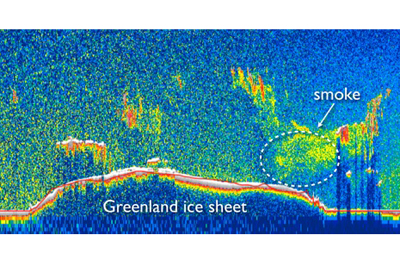Arctic Wildfire Soot Darkening Greenland Ice Sheet


The glittering, icy landscape of Greenland is being marred by soot that falls from the smoke plumes of Arctic wildfires, new satellite-based research shows. That soot darkens the surface of the ice and makes it absorb more sunlight, hastening its melt.
Researchers caught what they say are the first direct images of wildfire smoke drifting over Greenland this past summer with NASA's Cloud-Aerosol Lidar and Infrared Pathfinder Satellite Observation (CALIPSO) satellite, which they presented this week at the annual meeting of the American Geophysical Union in San Francisco.
Rising global temperatures are already contributing to the melting of the Greenland Ice Sheet, which experienced record melt this year and its warmest summer in 170 years, according to the National Oceanic and Atmospheric Administration's Arctic Report Card. Other research presented at the meeting reported that Greenland's ice loss is accelerating by 22 gigatons (22 cubic kilometers) of ice a year, with some areas, particularly the edges, losing ice faster than others.
Because meltwater is less reflective than ice, the surface of the ice sheet is already absorbing more sunlight — previous research found that the reflectivity of the Greenland ice has dropped by 6 percent in the last decade, according to an Ohio State University release on the new research.
This summer, in fact, virtually the entire surface veneer of the Greenland ice sheet melted in a matter of days, something that Ohio State researcher Jason Box, who worked on the CALIPSO research, says could start happening every summer.
Now, adding to the darkening of the surface that comes with more meltwater is the soot from Arctic tundra wildfires, another phenomenon that seems to be increasing with global warming. As these wildfires rage, atmospheric currents carry their smoke plumes over other areas, including Greenland, as the CALIPSO images show. The soot drops out from these plumes and darkens the ice sheet, exacerbating the feedback cycle of melting.
Box and his colleagues investigated the impact of these wildfires on Greenland by first using thermal images from NASA's Moderate Resolution Imaging Spectroradiometer (MODIS) to find the tundra fires. Computer models were used to project where the smoke from the fires would go, and they suggested that it could, in fact, reach Greenland.
Get the world’s most fascinating discoveries delivered straight to your inbox.
Armed with that information, the team looked at CALIPSO data and found evidence of the smoke over Greenland.
Just how much the soot from this smoke is impacting Greenland's melting can't be gleaned from the satellite data, though. To figure this out will take direct sampling of the ice sheet; Box is already organizing an expedition, dubbed The Dark Snow Project, for 2013, to the ice sheet to get these samples.
This story was provided by OurAmazingPlanet, a sister site to LiveScience. Follow OurAmazingPlanet for the latest in Earth science and exploration news on Twitter @OAPlanet. We're also on Facebook & Google+.

Andrea Thompson is an associate editor at Scientific American, where she covers sustainability, energy and the environment. Prior to that, she was a senior writer covering climate science at Climate Central and a reporter and editor at Live Science, where she primarily covered Earth science and the environment. She holds a graduate degree in science health and environmental reporting from New York University, as well as a bachelor of science and and masters of science in atmospheric chemistry from the Georgia Institute of Technology.


